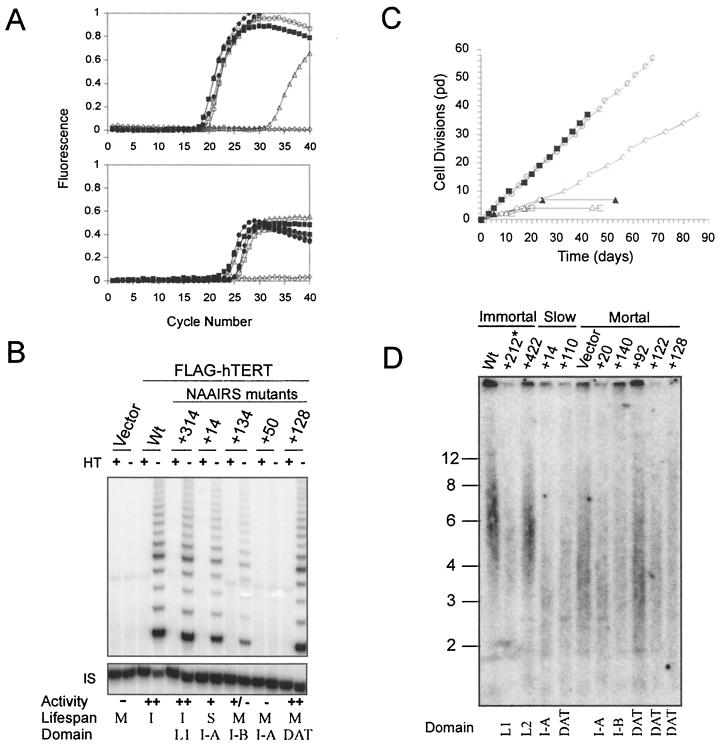FIG. 1.
Expression and telomerase activity of N-terminal hTERT mutants. (A) Total RNA was isolated from HA5 cell lines stably infected with vector (▵), FLAG-hTERT (▪, or FLAG-hTERT NAAIRS substitution mutants representative of nonessential (+212: ○), essential (+158, □), slow-growth (+110, ⧫), and biologically essential (+128, ●) and RT-PCR amplified with primers specific for hTERT by quantitative, real-time RT-PCR. The amount of transcript detected by fluorescence with FRET probes is plotted in arbitrary units against each PCR cycle (top panel). The housekeeping PBGD transcript was similarly measured to verify equivalent RNA addition per reaction (bottom panel), while H2O (◊) was assayed in both reactions as a negative control. (B) A total of 0.2 μg of lysate prepared from the described HA5 cell lines was assayed for telomerase activity by TRAP assay. As a control, a portion of the lysate was heat treated (HT) to inactivate telomerase prior to assaying. The internal standard (IS) served as a positive control for PCR amplification. Catalytic activity for each sample was normalized with the internal standard and is expressed as a percentage of wild-type FLAG-hTERT activity, indicated as follows: ++ (>60%), + (60 to 15%), +/− (<15%), and − (extremely low or no detectable activity). Domain refers to the location of the mutant, as described in the text. Life span (M, mortal; I, immortal; S, slow growth) as defined in the text. (C) Biologic activity of hTERT mutants was measured by serially passaging HA5 cell lines to determine whther cells entered crisis like vector or immortalized like wild-type hTERT. Representative clones are shown: vector (▴), FLAG-hTERT (▪), +212 (○), +50 (□), +14 (⋄), and +128 (▵). (D) Telomere length of representative HA5 cells infected with NAAIRS mutants that result in an immortal, slow-growth, or finite life span was determined by releasing the terminal restriction fragments of genomic DNA isolated from the described cell lines at early passage (pd 2 to 3) with the restriction enzymes HinfI and RsaI. These fragments were resolved and detected by Southern hybridization with a telomeric probe. ✽, Sample +212 was underloaded. Domain refers to the location of the mutant, as described in the text.

